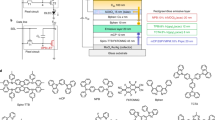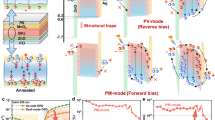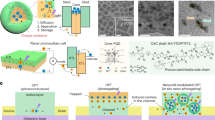Abstract
Organic semiconductor phototransistors have attracted remarkable academic and industry interest owing to their potential for applications in optoelectronic devices and for enhancing the performance of image sensors. Thanks to their high responsivity, typically attributed to substantial photoconductive gain mechanisms, these devices are well suited for detecting weak light. Here we introduce organic permeable base transistors as memory phototransistors, achieving high responsivity and detectivity. By leveraging the unique structure of organic permeable base transistors and conducting a detailed investigation into the underlying charge-storing mechanism, we achieve responsivity values as high as 109 A W−1, detectivity of 1015 Jones between 300 nm and 500 nm, and retention times exceeding 105 s. The excellent performance can be attributed to a charge carrier trapping process at the porous base electrode, as confirmed through comprehensive electrical and optical characterizations and technology computer-aided design (TCAD) simulations. These findings illustrate the potential of our organic permeable base transistors for sensitive photodetection applications, thereby paving the way for advancements in low-light imaging.
This is a preview of subscription content, access via your institution
Access options
Access Nature and 54 other Nature Portfolio journals
Get Nature+, our best-value online-access subscription
$32.99 / 30 days
cancel any time
Subscribe to this journal
Receive 12 print issues and online access
$259.00 per year
only $21.58 per issue
Buy this article
- Purchase on SpringerLink
- Instant access to full article PDF
Prices may be subject to local taxes which are calculated during checkout





Similar content being viewed by others
Data availability
The experimental data in the main figures are provided as source data in tabulated Excel files. Additional supporting data are available from the corresponding authors upon reasonable request. Source data are provided with this paper.
References
Pierre, A., Gaikwad, A. & Arias, A. C. Charge-integrating organic heterojunction phototransistors for wide-dynamic-range image sensors. Nat. Photon. 11, 193–199 (2017).
Rauch, T. et al. Near-infrared imaging with quantum-dot-sensitized organic photodiodes. Nat. Photon. 3, 332–336 (2009).
Guo, F. et al. A nanocomposite ultraviolet photodetector based on interfacial trap-controlled charge injection. Nat. Nanotechnol. 7, 798–802 (2012).
Kim, Y. et al. A hemispherical image sensor array fabricated with organic photomemory transistors. Adv. Mater. 35, 2203541 (2023).
Ren, H., Chen, J.-D., Li, Y.-Q. & Tang, J.-X. Recent progress in organic photodetectors and their applications. Adv. Sci. 8, 2002418 (2021).
Nie, R. et al. Highly sensitive and broadband organic photodetectors with fast speed gain and large linear dynamic range at low forward bias. Small 13, 1603260 (2017).
Coburn, C., Fan, D. & Forrest, S. R. Organic charge-coupled device. ACS Photon. 6, 2090–2095 (2019).
Bronstein, H., Nielsen, C. B., Schroeder, B. C. & McCulloch, I. The role of chemical design in the performance of organic semiconductors. Nat. Rev. Chem. 4, 66–77 (2020).
Guo, D., Yang, D., Zhao, J., Vadim, A. & Ma, D. Role of interfaces in controlling charge accumulation and injection in the photodetection performance of photomultiplication-type organic photodetectors. J. Mater. Chem. C 8, 9024–9031 (2020).
Winkler, L. C., Kublitski, J., Benduhn, J. & Leo, K. Photomultiplication enabling high-performance narrowband near-infrared organic photodetectors. Adv. Electron. Mater. 9, 2201350 (2023).
Kublitski, J. et al. Enhancing sub-bandgap external quantum efficiency by photomultiplication for narrowband organic near-infrared photodetectors. Nat. Commun. 12, 4259 (2021).
Wu, Y.-L., Fukuda, K., Yokota, T. & Someya, T. A highly responsive organic image sensor based on a two-terminal organic photodetector with photomultiplication. Adv. Mater. 31, 1903687 (2019).
Dan, Y., Zhao, X., Chen, K. & Mesli, A. A photoconductor intrinsically has no gain. ACS Photon. 5, 4111–4116 (2018).
Miao, J. & Zhang, F. Recent progress on photomultiplication type organic photodetectors. Laser Photon. Rev. 13, 1800204 (2019).
Xing, S. et al. Miniaturized VIS-NIR spectrometers based on narrowband and tunable transmission cavity organic photodetectors with ultrahigh specific detectivity above 1014 Jones. Adv. Mater. 33, 2102967 (2021).
Zhang, T. et al. High-performance filterless blue narrowband organic photodetectors. Adv. Funct. Mater. 34, 2308719 (2024).
Park, S., Lim, B. T., Kim, B., Son, H. J. & Chung, D. S. High mobility polymer based on a π-extended benzodithiophene and its application for fast switching transistor and high gain photoconductor. Sci. Rep. 4, 5482 (2014).
Jin, Z. & Wang, J. PIN architecture for ultrasensitive organic thin film photoconductors. Sci. Rep. 4, 5331 (2014).
Beesley, D. J. et al. Sub-15-nm patterning of asymmetric metal electrodes and devices by adhesion lithography. Nat. Commun. 5, 3933 (2014).
Shen, Y. et al. High-performance nanogap photodetectors based on 2D halide perovskites with a novel spacer cation. Adv. Funct. Mater. 34, 2403746 (2024).
Ren, X. & Chan, P. K. L. 23 bits optical sensor based on nonvolatile organic memory transistor. Appl. Phys. Lett. 104, 113302 (2014).
Zhou, Y. et al. An upconverted photonic nonvolatile memory. Nat. Commun. 5, 4720 (2014).
Zheng, L. et al. High-performance optical memory transistors based on a novel organic semiconductor with nanosprouts. Nanoscale 11, 7117–7122 (2019).
Wu, X. et al. High performance flexible multilevel optical memory based on a vertical organic field effect transistor with ultrashort channel length. J. Mater. Chem. C 7, 9229–9240 (2019).
Liu, X., Dong, G., Duan, L., Wang, L. & Qiu, Y. High performance low-voltage organic phototransistors: interface modification and the tuning of electrical, photosensitive and memory properties. J. Mater. Chem. 22, 11836–11842 (2012).
Kim, M. et al. Efficient organic photomemory with photography-ready programming speed. Sci. Rep. 6, 30536 (2016).
Wang, Q., Yang, J., Braun, S., Fahlman, M. & Liu, X. An organic memory phototransistor based on oxygen-assisted persistent photoconductivity. Org. Electron. 100, 106375 (2022).
Frolova, L. A. et al. Photoswitchable organic field-effect transistors and memory elements comprising an interfacial photochromic layer. Chem. Commun. 51, 6130–6132 (2015).
Kleemann, H. et al. Direct structuring of C60 thin film transistors by photo-lithography under ambient conditions. Org. Electron. 13, 506–513 (2012).
Park, B., Choi, S., Graham, S. & Reichmanis, E. Memory and photovoltaic elements in organic field effect transistors with donor/acceptor planar-hetero junction interfaces. J. Phys. Chem. C 116, 9390–9397 (2012).
Kleemann, H., Krechan, K., Fischer, A. & Leo, K. A review of vertical organic transistors. Adv. Funct. Mater. 30, 1907113 (2020).
Wang, J., Bonil, A., Vahland, J. & Kleemann, H. Reliable p-type organic permeable base transistors—the missing component for integrated circuits. Nano Futures 7, 035002 (2023).
Guo, E., Dollinger, F., Amaya, B., Fischer, A. & Kleemann, H. Organic permeable base transistors—insights and perspectives. Adv. Opt. Mater. 9, 2002058 (2021).
Dollinger, F. et al. Vertical organic thin-film transistors with an anodized permeable base for very low leakage current. Adv. Mater. 31, 1900917 (2019).
Kheradmand-Boroujeni, B. et al. A pulse-biasing small-signal measurement technique enabling 40 MHz operation of vertical organic transistors. Sci. Rep. 8, 7643 (2018).
Bonil, A. et al. Organic permeable base transistors—reliable large-scale anodization for high frequency devices. Adv. Funct. Mater. 35, 2418270 (2025).
Kaschura, F. et al. Operation mechanism of high performance organic permeable base transistors with an insulated and perforated base electrode. J. Appl. Phys. 120, 094501 (2016).
Darbandy, G. et al. Unraveling structure and device operation of organic permeable base transistors. Adv. Electron. Mater. 6, 2000230 (2020).
Klinger, M. P. et al. Organic power electronics: transistor operation in the kA/cm2 regime. Sci. Rep. 7, 44713 (2017).
Hahn, T. et al. Role of intrinsic photogeneration in single layer and bilayer solar cells with C60 and PCBM. J. Phys. Chem. C 120, 25083–25091 (2016).
Pai, D. M. & Enck, R. C. Onsager mechanism of photogeneration in amorphous selenium. Phys. Rev. B 11, 5163–5174 (1975).
Shibuta, M. et al. Direct observation of photocarrier electron dynamics in C60 films on graphite by time-resolved two-photon photoemission. Sci. Rep. 6, 35853 (2016).
Frankevich, E., Maruyama, Y., Ogata, H., Achiba, Y. & Kikuchi, K. Mobilities of charge carriers in C60 orthorhombic single crystal. Solid State Commun. 88, 177–181 (1993).
Kotadiya, N. B., Mondal, A., Blom, P. W. M., Andrienko, D. & Wetzelaer, G.-J. A. H. A window to trap-free charge transport in organic semiconducting thin films. Nat. Mater. 18, 1182–1186 (2019).
Mort, J., Machonkin, M., Ziolo, R. & Chen, I. Electronic carrier transport and photogeneration in buckminsterfullerene films. Appl. Phys. Lett. 61, 1829–1831 (1992).
Lisiansky, M. et al. Peculiarities of hole trapping in Al2O3-SiO2 gate dielectric stack. Microelectron. Reliab. 79, 265–269 (2017).
Larcher, L., Padovani, A., Della Marca, V., Pavan, P. & Bertacchini, A. Investigation of trapping/detrapping mechanisms in Al2O3 electron/hole traps and their influence on TANOS memory operations. In Proc. 2010 International Symposium on VLSI Technology, System and Application 52–53 (IEEE, 2010).
Strand, J., Dicks, O. A., Kaviani, M. & Shluger, A. L. Hole trapping in amorphous HfO2 and Al2O3 as a source of positive charging. Microelectron. Eng 178, 235–239 (2017).
Geiger, M. et al. Quantitative analysis of the density of trap states in semiconductors by electrical transport measurements on low-voltage field-effect transistors. Phys. Rev. Appl. 10, 044023 (2018).
Darbandy, G., Pashaki, E. R., Iniguez, B., Kleemann, H. & Kloes, A. Modeling and simulation of vertical organic permeable base transistors. In 2024 IEEE Latin American Electron Devices Conference (LAEDC) 1–4 (IEEE, 2024).
Darbandy, G. et al. High-frequency fT and fmax in organic transistors: performance and perspective. Adv. Electron. Mater. 10, 2300715 (2024).
Stadtmüller, B. et al. Strong modification of the transport level alignment in organic materials after optical excitation. Nat. Commun. 10, 1470 (2019).
Emmerich, S. et al. Ultrafast charge-transfer exciton dynamics in C60 thin films. J. Phys. Chem. C 124, 23579–23587 (2020).
Bai, S. et al. Nanographene-based heterojunctions for high-performance organic phototransistor memory devices. Adv. Sci. 10, 2300057 (2023).
He, Z. et al. Photomemory and pulse monitoring featured solution-processed near-infrared graphene/organic phototransistor with detectivity of 2.4 × 1013 Jones. Adv. Funct. Mater. 31, 2103988 (2021).
Tao, J. et al. Organic UV-sensitive phototransistors based on distriphenylamineethynylpyrene derivatives with ultra-high detectivity approaching 1018. Adv. Mater. 32, 1907791 (2020).
Chow, P. C. Y. et al. Dual-gate organic phototransistor with high-gain and linear photoresponse. Nat. Commun. 9, 4546 (2018).
Zheng, X. et al. Optical-fiber-integrated high-speed organic phototransistor with broadband imaging capacity. Opt. Express 31, 33378–33386 (2023).
Wang, C. et al. N-type 2D organic single crystals for high-performance organic field-effect transistors and near-infrared phototransistors. Adv. Mater. 30, 1706260 (2018).
Chen, Y., Chu, Y., Wu, X., Ou-Yang, W. & Huang, J. High-performance inorganic perovskite quantum dot–organic semiconductor hybrid phototransistors. Adv. Mater. 29, 1704062 (2017).
Ji, D. et al. Band-like transport in small-molecule thin films toward high mobility and ultrahigh detectivity phototransistor arrays. Nat. Commun. 10, 12 (2019).
Xu, H. et al. Flexible organic/inorganic hybrid near-infrared photoplethysmogram sensor for cardiovascular monitoring. Adv. Mater. 29, 1700975 (2017).
Zhang, Y. et al. Enabling a high-sensitivity and fast-response organic phototransistor based on an “embedded” heterojunction toward broadband high-speed imaging. Cryst. Growth Des. 24, 2783–2790 (2024).
Zhang, S. et al. Photovoltaic nanocells for high-performance large-scale-integrated organic phototransistors. Nat. Nanotechnol. 19, 1323–1332 (2024).
Yeliu, K. et al. High performance n-type vertical organic phototransistors. Org. Electron. 67, 200–207 (2019).
Shou, M. et al. Ultrahigh detectivity in spatially separated hole/electron dual traps based near-infrared organic phototransistor. Adv. Opt. Mater. 9, 2002031 (2021).
Gao, Y. et al. A novel hybrid-layered organic phototransistor enables efficient intermolecular charge transfer and carrier transport for ultrasensitive photodetection. Adv. Mater. 31, 1900763 (2019).
Liu, X., Lee, E. K., Kim, D. Y., Yu, H. & Oh, J. H. Flexible organic phototransistor array with enhanced responsivity via metal–ligand charge transfer. ACS Appl. Mater. Interfaces 8, 7291–7299 (2016).
Xu, H. et al. A high-sensitivity near-infrared phototransistor based on an organic bulk heterojunction. Nanoscale 5, 11850–11855 (2013).
Du, Q. et al. Highly sensitive and ultrafast organic phototransistor based on rubrene single crystals. ACS Appl. Mater. Interfaces 13, 57735–57742 (2021).
Zhong, J. et al. High performance flexible organic phototransistors with ultrashort channel length. ACS Photon. 5, 3712–3722 (2018).
Rim, Y. S. et al. Boosting responsivity of organic–metal oxynitride hybrid heterointerface phototransistor. ACS Appl. Mater. Interfaces 8, 14665–14670 (2016).
Xie, C., You, P., Liu, Z., Li, L. & Yan, F. Ultrasensitive broadband phototransistors based on perovskite/organic-semiconductor vertical heterojunctions. Light Sci. Appl. 6, e17023 (2017).
Li, F. et al. High-performance near-infrared phototransistor based on n-type small-molecular organic semiconductor. Adv. Electron. Mater. 3, 1600430 (2017).
Mukherjee, B. et al. Organic phototransistors based on solution grown, ordered single crystalline arrays of a π-conjugated molecule. J. Mater. Chem. 22, 3192–3200 (2012).
Hoang, M. H. et al. Unusually high-performing organic field-effect transistors based on π-extended semiconducting porphyrins. Adv. Mater. 24, 5363–5367 (2012).
Jones, G. F. et al. Highly efficient rubrene–graphene charge-transfer interfaces as phototransistors in the visible regime. Adv. Mater. 29, 1702993 (2017).
Du, L. et al. Toward facile broadband high photoresponse of fullerene based phototransistor from the ultraviolet to the near-infrared region. Carbon 96, 685–694 (2016).
Zhang, Y., Yuan, Y. & Huang, J. Detecting 100 fW cm−2 light with trapped electron gated organic phototransistors. Adv. Mater. 29, 1603969 (2017).
Chen, M.-N. et al. Unveiling the photoinduced recovery mystery in conjugated polymer-based transistor memory. ACS Appl. Mater. Interfaces 13, 44656–44662 (2021).
Pei, K. et al. A high-performance optical memory array based on inhomogeneity of organic semiconductors. Adv. Mater. 30, 1706647 (2018).
Li, W. et al. Solution-processed wide-bandgap organic semiconductor nanostructures arrays for nonvolatile organic field-effect transistor memory. Small 14, 1701437 (2018).
Liao, M.-Y. et al. Realizing nonvolatile photomemories with multilevel memory behaviors using water-processable polymer dots-based hybrid floating gates. ACS Appl. Electron. Mater. 3, 1708–1718 (2021).
Yang, H. et al. High-performance all-inorganic perovskite-quantum-dot-based flexible organic phototransistor memory with architecture design. Adv. Electron. Mater. 5, 1900864 (2019).
Fuentes-Hernandez, C. et al. Large-area low-noise flexible organic photodiodes for detecting faint visible light. Science 370, 698–701 (2020).
Strobel, N. et al. Color-selective printed organic photodiodes for filterless multichannel visible light communication. Adv. Mater. 32, 1908258 (2020).
Song, Y., Yu, G., Xie, B., Zhang, K. & Huang, F. Visible-to-near-infrared organic photodiodes with performance comparable to commercial silicon-based detectors. Appl. Phys. Lett. 117, 093302 (2020).
Nikolis, V. C. et al. Strong light-matter coupling for reduced photon energy losses in organic photovoltaics. Nat. Commun. 10, 3706 (2019).
Acknowledgements
We acknowledge funding for the project ‘FLEXMONIRS’ (01DR20008A) provided by the German Federal Ministry of Education and Research (BMBF) and the Koselleck-project (456344071) from the German Research Foundation (DFG). L.C.W. acknowledges the Graduate Academy project 2767 (GRK 2767) funded by DFG. G.D. acknowledges the DFG projects ‘DA 2578/2-1’ and ‘INST169/22-1’. H.K. acknowledges funding for DFG project KL 2961/10-1 (496804567) and 495141293. J.B. and L.C.W. gratefully acknowledges funding from the Federal Ministry of Research, Technology and Space (BMFTR) as part of the project to establish the German Center for Astrophysics (03WSP1745). We acknowledge M. Roth for stimulating discussions about detector applications and K.-G. Lim for discussions about the OPBTs.
Author information
Authors and Affiliations
Contributions
J.S., K.L., H.K. and J.B. proposed and supervised the project. J.S., A.B. and J.W. designed and prepared the samples. J.S. designed the experiments together with A.B. and L.C.W. J.S. performed the device characterization and carried out the wavelength-dependent threshold analysis and noise measurements with L.C.W. G.D. performed the TCAD simulations. J.S. analysed the data, implemented the modelling of the observed effects and wrote the paper. J.F. analysed the OPBTs doped with absorber materials. All authors discussed the results and commented on the paper.
Corresponding authors
Ethics declarations
Competing interests
The authors declare no competing interests.
Peer review
Peer review information
Nature Photonics thanks Nicola Gasparini and Debdatta Panigrahi for their contribution to the peer review of this work.
Additional information
Publisher’s note Springer Nature remains neutral with regard to jurisdictional claims in published maps and institutional affiliations.
Supplementary information
Supplementary Information
Supplementary Figs. 1–18, Notes 1–4 and Tables 1–3.
Source data
Source Data Fig. 1
Raw data of main text Fig. 1.
Source Data Fig. 2
Raw data of main text Fig. 2.
Source Data Fig. 3
Raw data of main text Fig. 3.
Source Data Fig. 4
Raw data of main text Fig. 4.
Source Data Fig. 5
Raw data of main text Fig. 5.
Rights and permissions
Springer Nature or its licensor (e.g. a society or other partner) holds exclusive rights to this article under a publishing agreement with the author(s) or other rightsholder(s); author self-archiving of the accepted manuscript version of this article is solely governed by the terms of such publishing agreement and applicable law.
About this article
Cite this article
Schröder, J., Bonil, A., Winkler, L.C. et al. Organic permeable base transistors for high-performance photodetection with photo-memory effect. Nat. Photon. 19, 1088–1098 (2025). https://doi.org/10.1038/s41566-025-01740-y
Received:
Accepted:
Published:
Issue date:
DOI: https://doi.org/10.1038/s41566-025-01740-y



